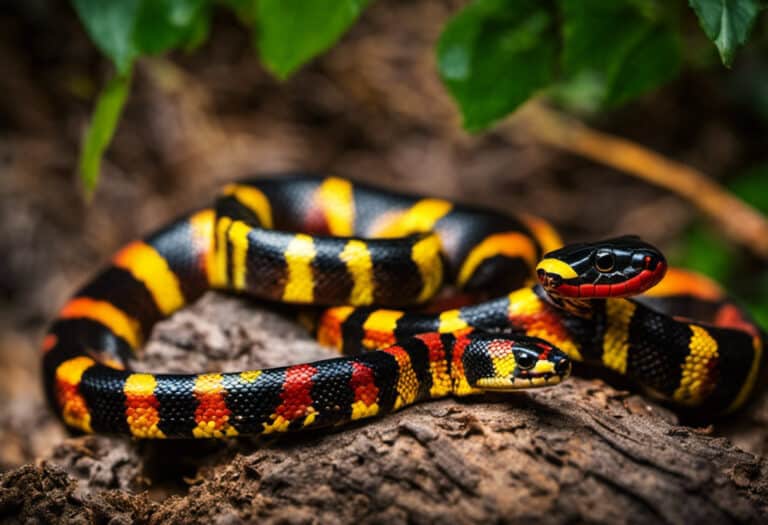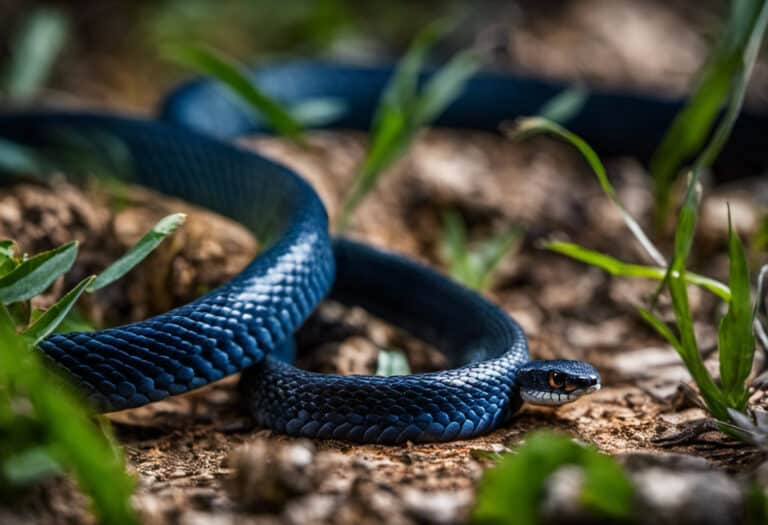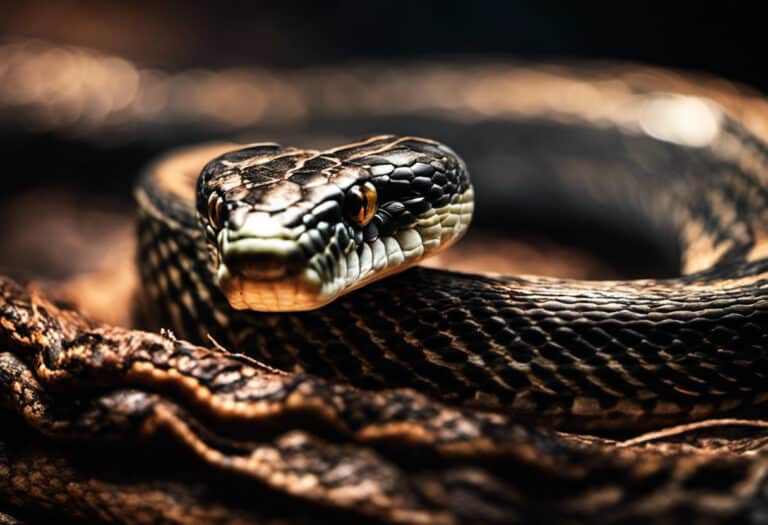9 Types of Non Venomous Snakes
Looking to expand your knowledge of non-venomous snakes? Well, you’re in luck! This article will take you on a journey through the mesmerizing world of these slithering creatures.
From the Eastern Hognose Snake with its unique defense mechanisms, to the elegant Ribbon Snake known for its sleek appearance, we’ll explore seven different types of non-venomous snakes.
Get ready to uncover their fascinating behaviors, habitats, and more.
So, if you’re ready to dive into the captivating realm of snakes, let’s get started!
1) Eastern Hognose Snake
You may encounter the Eastern Hognose Snake in the Southeastern United States, known for its distinctive upturned snout and its ability to play dead when threatened.
This fascinating snake, scientifically known as Heterodon platirhinos, is a non-venomous species that can be found in a variety of habitats, including forests, fields, marshes, and sandy areas. However, it tends to prefer sandy or loamy soils in open grasslands or pine barrens.
The Eastern Hognose Snake also shares its habitat with other snake species, such as Garter snakes, which can be commonly found in wetlands, meadows, and even urban areas. Despite their differences, both snake species play important roles in maintaining ecosystem balance by controlling populations of small mammals and insects.
2) Garter Snake
The Garter Snake (Thamnophis sirtalis) is a common species of non-venomous snake found throughout North America. It has a slender body with distinctive longitudinal stripes that vary in color and pattern, depending on the specific subspecies.
Garter snakes are highly adaptable and can be found in a variety of habitats, including grasslands, forests, wetlands, and even urban areas. They’re active during the day and are known for their ability to swim and climb trees, making them versatile predators that feed on a wide range of prey, from insects to small mammals.
3) Garter Snake Habitats
Garter snakes can be found in a variety of habitats, such as meadows, forests, and wetlands. These adaptable snakes are known for their ability to thrive in different environments.
In terms of diet, garter snakes are carnivorous and feed on a wide range of prey, including insects, worms, frogs, and small mammals.
Their reproductive strategy is unique as well. They’re ovoviviparous, meaning that they give birth to live young instead of laying eggs. Females can give birth to anywhere from 12 to 40 babies in a single litter. The young snakes are independent from birth and start hunting for their own food right away.
Garter snakes are fascinating creatures that have successfully adapted to various habitats, making them a common sight in many regions.
4) Garter Snake Behavior Patterns?
If you observe garter snakes in different habitats, you’ll notice their unique behavior patterns. Garter snakes, belonging to the genus Thamnophis, are known for their adaptability and wide distribution across North America.
Here are some interesting behaviors exhibited by these fascinating reptiles:
-
Garter snake diet: Garter snakes are carnivorous and primarily feed on small prey such as insects, worms, slugs, and amphibians. They’re opportunistic hunters and possess a specialized jaw structure that allows them to consume prey larger than their own head size.
-
Garter snake reproduction: Garter snakes have a unique reproductive strategy known as ‘matrotrophy.’ This means that instead of laying eggs, they give birth to live young. Mating usually occurs in spring or early summer, and females can store sperm for several months before fertilization takes place. They give birth to a litter of 10 to 40 offspring, with the number varying depending on the species and environmental conditions.
Understanding these behavior patterns can provide valuable insights into the ecology and evolutionary biology of garter snakes.
5) Rat Snake
You might come across a Rat Snake while exploring the Southeastern United States, known for its black and yellow coloration. Rat snakes, scientifically known as Elaphe obsoleta, are non-venomous reptiles that belong to the Colubridae family.
These snakes are highly adaptable and can be found in a variety of habitats, including forests, swamps, fields, and even urban areas. They’re excellent climbers and can often be seen in trees, searching for prey or basking in the sun. Rat snakes are active during the day and are known for their agility and speed.
They’re opportunistic feeders, consuming a wide range of prey, including rodents, birds, and eggs. When threatened, rat snakes may vibrate their tails, hiss, or even strike, although they’re generally non-aggressive towards humans. These fascinating creatures play a vital role in controlling rodent populations and are a valuable part of the ecosystem.
6) King Snake
The King Snake, scientifically known as Lampropeltis getula, is a non-venomous snake found in various regions of North and Central America.
It’s recognized for its striking pattern of black and white or yellow bands that run along its body.
These snakes are known for their aggressive behavior towards other snakes, often consuming them as part of their diet.
King snakes can be found in a variety of habitats, including forests, grasslands, and deserts. These snakes are known for their adaptability and ability to thrive in diverse environments.
Here are some key points about the king snake’s diet and predators:
-
Diet: King snakes are opportunistic eaters and have a diverse diet. They primarily feed on rodents, such as mice and rats, but they also consume other small mammals, birds, eggs, and even other snakes. This varied diet allows them to survive in different habitats and ensures they get the necessary nutrients.
-
Predators: While king snakes are powerful predators themselves, they also have their own set of predators. Some of their main predators include birds of prey, larger snakes, and mammals such as coyotes and foxes. However, their resistance to venomous snake bites gives them an advantage when encountering other snakes.
King Snake Behavior
If you encounter a king snake in the wild, it may exhibit defensive behavior such as hissing, coiling, and rattling its tail to deter potential threats. King snakes are known for their ability to mimic the appearance and behavior of venomous snakes, which helps protect them from predators.
They’re non-venomous and play an important role in controlling populations of rodents and other small animals. King snakes have a diverse diet, including rodents, birds, eggs, lizards, and other snakes, earning them the nickname ‘king’ due to their ability to prey on other snakes, including venomous ones.
However, king snakes also have their own predators, such as birds of prey, larger snakes, and mammals. Despite their defensive behavior, king snakes are generally harmless to humans and should be appreciated for their role in maintaining ecological balance.
7) Ribbon Snake
The Ribbon Snake, a non-venomous snake found in North America, is known for its slender body and distinctive striped pattern. These graceful creatures can be found in a variety of habitats, including wetlands, marshes, and meadows.
Ribbon snakes are highly active and agile, often seen swimming or climbing trees in search of prey. They primarily feed on small amphibians and insects, using their quick reflexes and excellent eyesight to catch their prey.
While they aren’t venomous, ribbon snakes may bite if threatened, but their bites are harmless to humans. These snakes are also known for their docile nature and tend to flee rather than confront predators.
Eastern hognose snakes, on the other hand, prefer sandy habitats and are known for their unique defensive behavior of flattening their heads and hissing to appear larger and more threatening.
8) Corn Snake
When it comes to caring for corn snakes, there are a few key factors to keep in mind. First and foremost, providing the right habitat is essential. Corn snakes need a spacious enclosure with a temperature gradient, allowing them to regulate their body temperature. A secure lid is also important to prevent any escapes.
Secondly, their diet consists primarily of mice or rats. It’s crucial to feed them appropriately sized prey to ensure proper digestion.
Lastly, regular handling is beneficial for their socialization and overall well-being.
Moving on to the Eastern hognose snake, their feeding habits are quite fascinating. These snakes have a specialized diet that includes primarily toads and frogs. They’ve a unique method of hunting where they use their upturned snout to dig and locate their prey.
Once they find a toad or frog, they’ll use their rear fangs to inject a mild venom that aids in subduing their meal. Eastern hognose snakes are fascinating creatures with intriguing feeding habits.
9) Water Snake
Water snakes can be found in a variety of habitats, including rivers, lakes, and wetlands. These snakes are well-adapted to aquatic environments, with streamlined bodies and keeled scales that help them move through the water with ease. They’re excellent swimmers and can often be seen basking on rocks or logs near the water’s edge.
Water snakes are opportunistic feeders, consuming a diet that primarily consists of fish, frogs, and other small aquatic prey. They use their powerful jaws and sharp teeth to catch and subdue their prey.
One species of water snake, the eastern hognose snake, has a unique feeding habit. It specializes in eating toads and has developed a specialized set of teeth that allow it to puncture and deflate the toad’s poison glands before swallowing it whole.
Overall, water snakes are fascinating creatures with diverse habits and diets that allow them to thrive in their watery habitats.
Frequently Asked Questions
What Are the Common Habitats of Non-Venomous Snakes?
Common habitats of non-venomous snakes include forests, woodlands, grasslands, deserts, wetlands, and even urban areas. These snakes have adapted to various environments, demonstrating their versatility and ability to thrive in diverse ecosystems.
How Do Non-Venomous Snakes Reproduce and Care for Their Young?
Non-venomous snakes reproduce through various methods such as internal fertilization or egg-laying. Some species, like milk snakes, lay eggs and provide no parental care, while others, like boas, give live birth and exhibit varying degrees of parental care.
What Are the Distinguishing Characteristics of Each Type of Non-Venomous Snake Mentioned?
Non-venomous snakes have distinguishing physical characteristics and habitat preferences. They vary in color, size, and pattern. Some prefer arboreal habitats, while others are primarily ground-dwellers. Understanding these traits helps in their identification and conservation efforts.
Are There Any Specific Behaviors or Traits That Non-Venomous Snakes Exhibit?
Non-venomous snakes have fascinating behaviors and traits. They exhibit diverse feeding habits, from consuming insects to rodents. As for defense, some mimic venomous species, while others rely on camouflage or bluffing.
How Can One Differentiate Between Non-Venomous Snakes and Venomous Snakes in the Same Region?
To differentiate between venomous and non-venomous snakes in the same region, look for specific physical characteristics like head shape, eye shape, and scale patterns. Educate yourself on local species and snake bite prevention measures for freedom and safety.
Conclusion
Congratulations!
You’ve now delved into the captivating world of non-venomous snakes. These remarkable creatures, from the Eastern Hognose Snake to the Water Snake, have revealed their unique characteristics and behaviors.
As you’ve explored their preferred habitats, feeding habits, and even their mating rituals, you’ve gained a comprehensive understanding of the diverse wildlife that surrounds us.
So next time you encounter one of these slithering wonders, remember the intricate life cycles and appreciate the beauty that lies within their serpentine forms.






